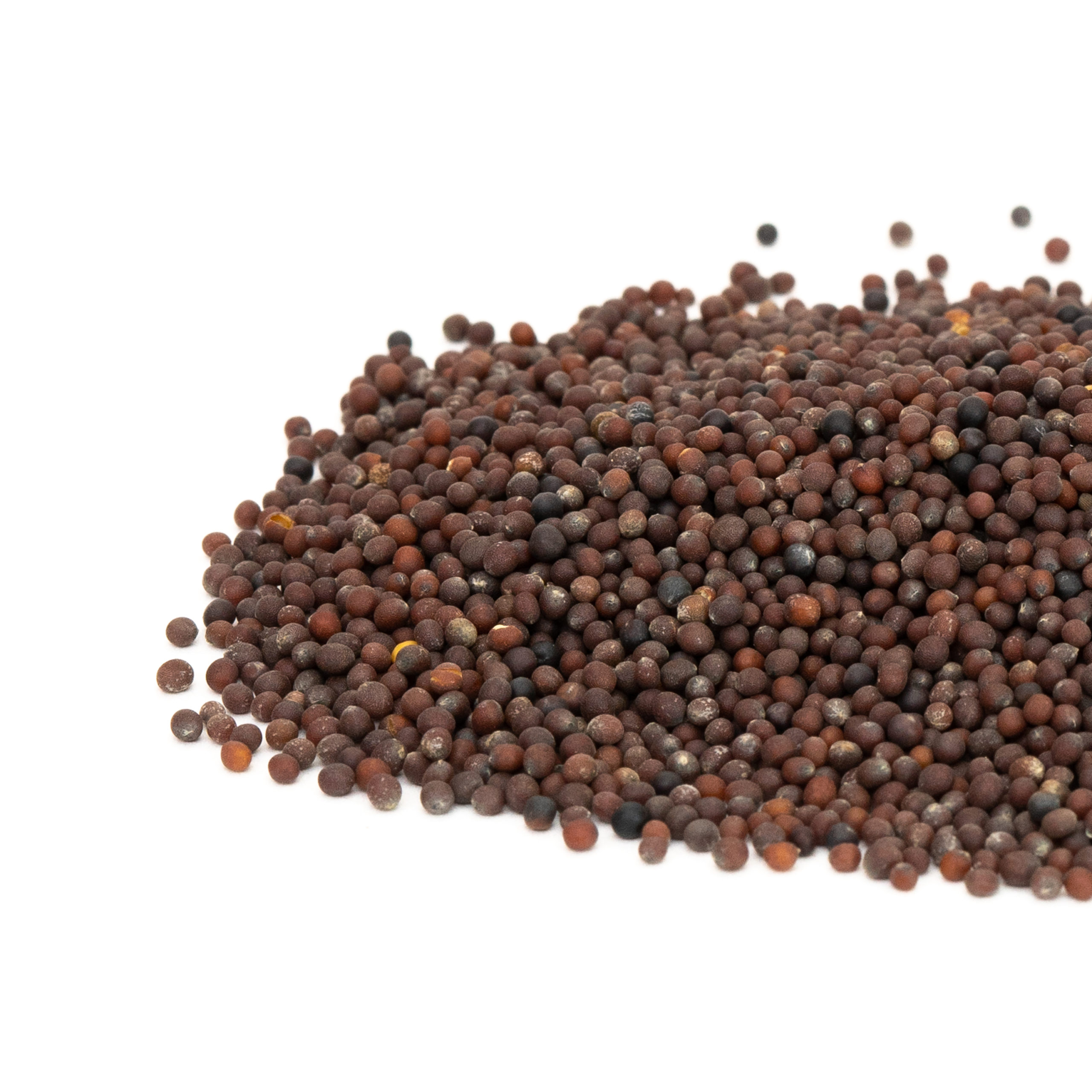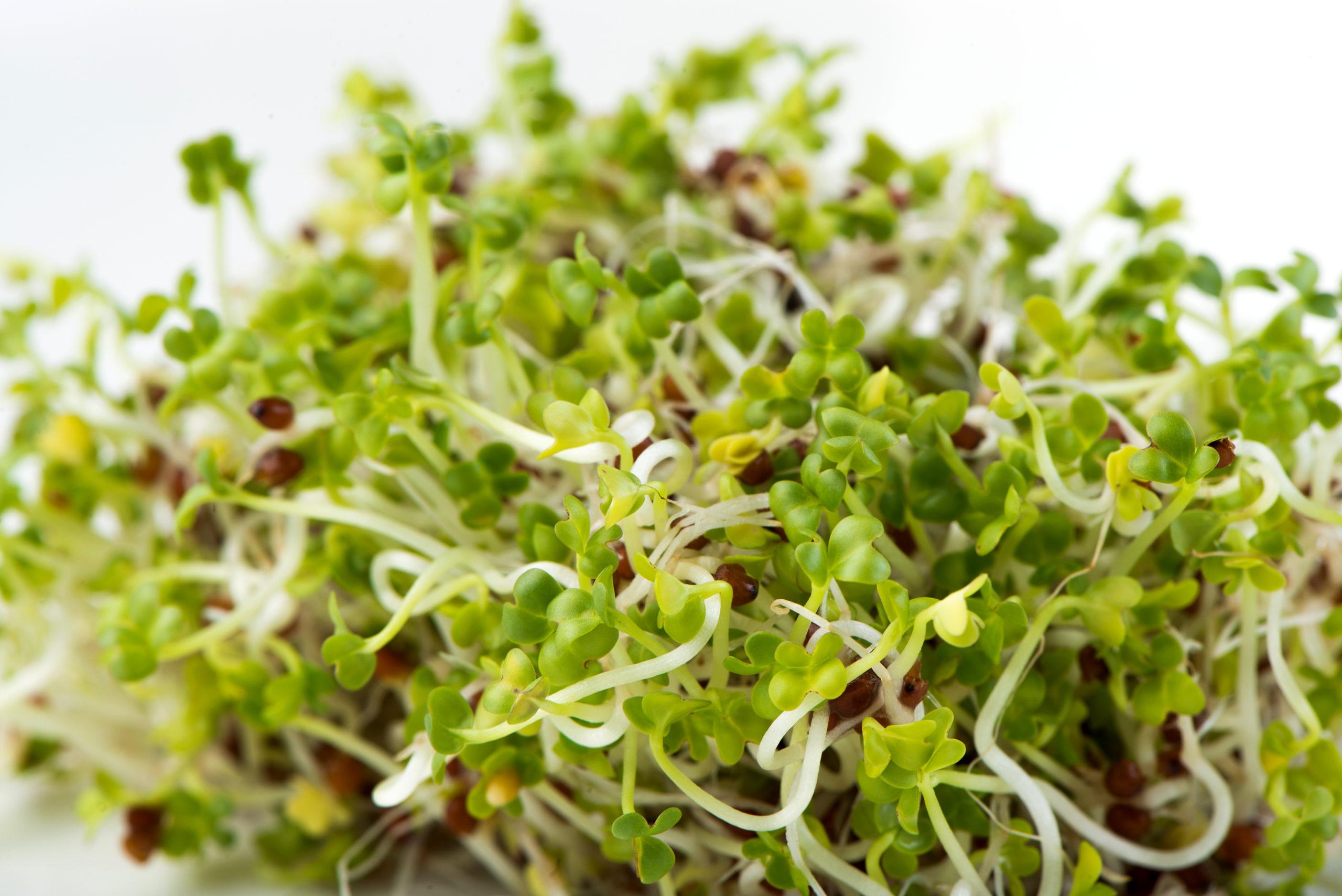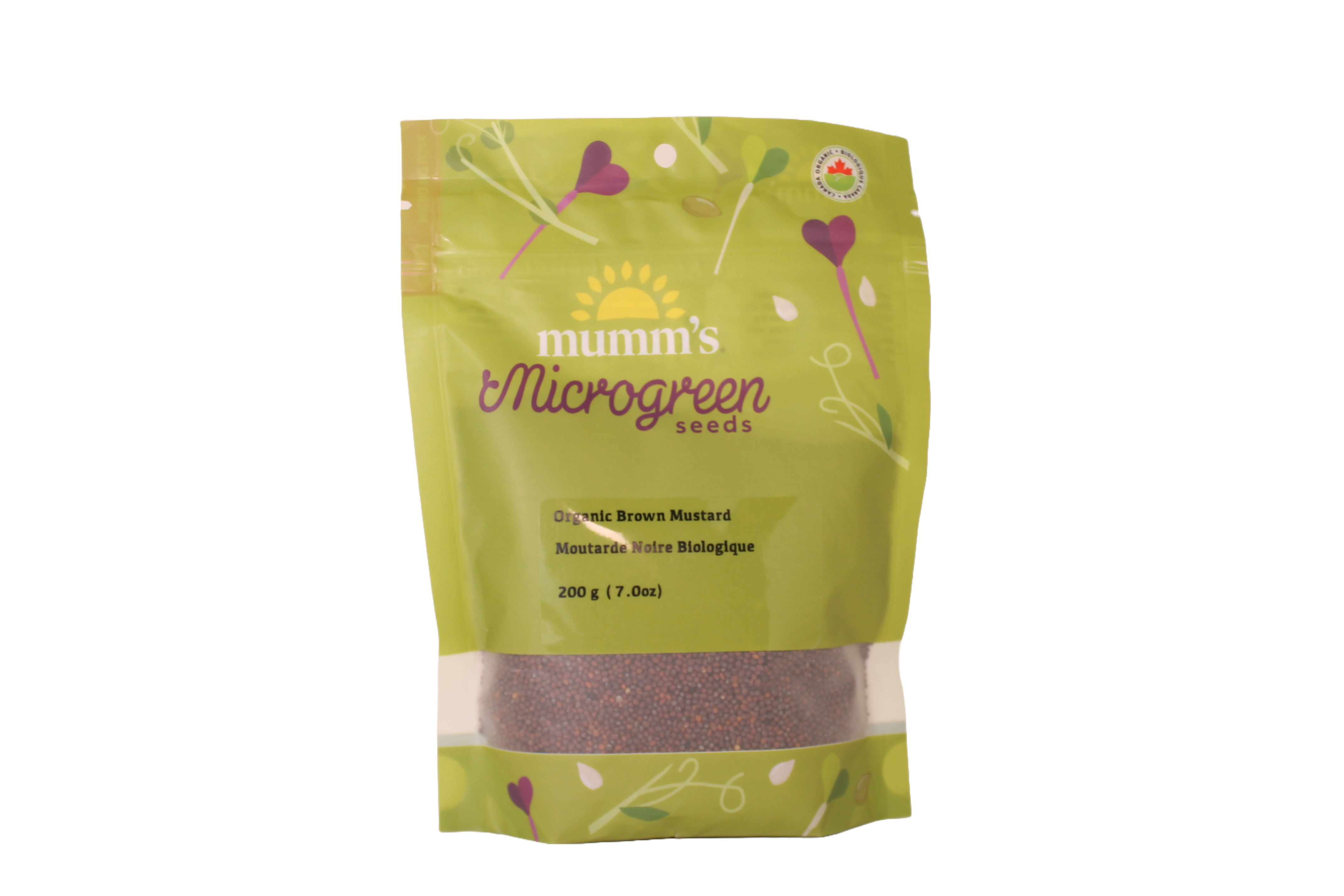A spicy hot addition to sandwiches or salads.
Grow Microgreens!
Soilless Method (broccoli, mustard)
Soak. Using a tray with drainage holes, rinse enough seed to cover the bottom of the tray. Soak the seed for 1-2 hours. Use a jar with a sprouting lid for soaking if the tray holes are too large. Drain, rinse and drain holding at an angle to remove excess water. Spread the seed evenly on the bottom of the tray and cover with a lid top and bottom or put in plastic bag.
Rinse. Rinse with cold water twice a day, using either a gentle flow from a tap, dipping in a sink, or spraying. Drain thoroughly.
Grow. The roots will form a mat from which the microgreens will emerge. At that point, put in indirect sunlight, florescent/LED lights or grow lights. The watering is then easy: fill the container 1 cm deep with water and allow to sit for a few seconds in the water and then tilt on an angle to decant the water until only some moisture is remaining remaining in the root area. Continue to rinse twice a day as described above.
Harvest!
Typically, microgreens grown without soil are harvested at 7-10 days. Harvest before the next expected rinse so the shoots are dry. Harvest before the next expected rinse so the shoots are dry. Harvest microgreens using scissors or knife.
Instead of harvesting all at once, you can start to harvest microgreens as soon as the first two leaves are spread out. Take only what you need for your meal and allow the rest to keep growing or put the tray in the fridge loosely covered and a plastic bag or dome to harvest another day.
Grow Microgreens!
Soil Method (small seed)
You will need:
• 10” x 20” gardening trays (1-inch-tall preferred), 1 with
holes + 1 without. Smaller microgreen trays also work well.
• Good quality organic starting soil mix
• Parchment paper or unbleached paper towel (optional).
• Dome lids (clear or black) or plastic sheet
• Organic seed
• Mister bottle, cup measures, garden spray nozzle (optional)
• Scissors or sharp knife
1. Don’t soak small or medium size seed. Small seed such as broccoli and arugula are easier to sprinkle on top of the soil if they are not soaked.
2. Prepare Soil
Add water to top of the bag (or each tray) 12 hours ahead of use until almost fully hydrated. Rehydrate the bag as necessary. If you were to put the soil in your hand and squeeze it, you should not be able to get much more than a drop of water out of it for the perfect moisture content. If you want to mist the seed after putting it on the soil, reduce the water hydration of the bagged soil a bit.
TIP: To check for overwatering, tip the tray to one end. Water should not pool enough to drip out of the tray.
3. Fill Trays with Soil
Use a tray with holes. Fill with 3/4-1.5” of soil. The closer to the top of the tray the better aid to air circulation. Use a block or your hand to smooth and flatten the soil without compacting it. The back of a tablespoon or spatula smooths out the valleys. You can wait to put the tray without holes under until after unstacking/uncovering or add it to the bottom now.
TIP: Place a layer or two of paper towel on the bottom of the tray before adding soil for easier cleanup.
4. Sow the Seed
Sprinkle the seed evenly over the soil in the tray (pizza cheese shaker, spoon). The seeding density depends on the stage at which you’re planning to harvest. For small seeds for 1-week microgreens, start with approximately 15 -28 grams (1.5 – 2 Tbsp). Sow slightly less seed for 2-3 week microgreens.
Seeds do not need misting if the soil has enough moisture. Mist if you need more moisture. Use a spray bottle or a garden spray nozzle set to light mist. The soil should be moist throughout, but not soaking wet.
5. Cover the Seed
Doing away with soil as a seed cover decreases the work and time it takes to grow the greens. If stacking the trays on top of each other, use a cover directly on the seed like parchment paper, a plastic sheet or wet unbleached paper towel layer. When not stacking trays, the seed will need protection from drying out by using a dome/lid. Use a clear dome or an inverted 10 x 20” tray without holes. For smaller trays, use several layers of unbleached paper towels folded onto itself with or without a plastic sheet covering the top.
TIP: Most microgreens will grow taller when you keep the light out at the beginning, but this may make the stem weaker. Most seeds germinate in the light no problem.
6. Stack Trays or Cover with Lids
Stacking helps to quickly force the roots into the soil, provides darkness, promotes even germination/growth. Stack 2-5 filled trays on top of each other with an empty tray on the top of the stack with a weight in it. Check at least once a day to see if the trays need water. Cabbage family seed sprouts quickly, so stack for 2-3 days. Others stack 3-5 days.
If choosing not to stack, simply cover the trays with clear or black-out plastic, a lid or dome. Check at least once a day to see if the trays need water. Cover for the same number of days as above.
7. Expose to Indirect Sunlight, Florescent/LED or Grow Lights.
After 2-5 days, the microgreens should be ready for light. If the microgreens begin to get quite tall and leggy, this is an indication that they may need a bit more light.
8. Water the Growing Microgreens
Check the seed once or twice daily and water as needed. The soil should be moist, not wet. Once trays are unstacked, add water from below into the no holes tray as necessary.
9. Harvest!
Microgreens are harvested at 1-3 weeks with scissors or a sharp knife. Make sure microgreens are not damp before storing. If needed, you may use a small fan or salad spinner to dry the microgreens before storing in a sealed container in the fridge.
Instead of harvesting all at once, you can start to harvest microgreens as soon as the first two leaves are spread out. Take only what you need for your meal and allow the rest to keep growing or put the tray in the fridge loosely covered and a plastic bag or dome to harvest another day. Water as necessary.
10. Enjoy!
Microgreens make everything better, so have fun with them and add them to your favourite dishes!
Helpful tips:
• To moisten your bag of soil, add water ahead until almost fully hydrated.
• The roots grow under the soil so it works well to water from below if the tray has holes in it, or open the side of the tray and pour water beside the soil when using flexible plastic trays. Otherwise misting or watering from the top works well too.
unglazed clay surfaceunbleached paper towelunbleached coffee filtersoilbaby blanket Water carefuly or mist lightly using spray bottle. Do not allow to dry out.




Dawn –
I haven’t been able to produce sprouts yet. I am on my second try. I was hoping to be able to try these seeds in jars along with my other ones, but I think that I am going to have to try the other method, clay pot. I can’t comment on the flavour just yet.
Dennis Major –
These Brown Mustard seeds are very slow to germinate and relatively low germination rates. Don’t know if this is their nature or whether they are old less viable seeds.
I use mustard sprouts in combination with broccoli sprouts. Mustard when combined with Broccoli enhances its benefits so I’m thinking of grinding the seeds after a few days of soaking and rinsing to use as an additive to the broccoli sprouts.
Oriental Mustard which I also purchased in comparison sprouted quickly and at high rates.
sara –
Nice seeds grow well.
Growgirl –
I love these as short, sprouts with sprouted barley in a soup. They are a Winter staple for me.
slick –
Ordered again and was great! I only wish they had yellow mustard also so I could vary the heat.
Shelly –
These are growing very well in hemp mats 🙂
Elaine –
Just to say I’ve tried the wasabi – which is very tasty and spicier but did not grow well for me. This mustard is not quite as tasty (to our way of thinking) but it does grow well. I’m sprinkling it on some other seeds after they have soaked (ie alfalfa and clover) with much success!